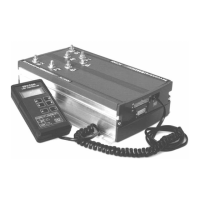22
nd
October 2004 SC2000 Manual – 177/52301 Rev G Page 13
Pin Main Function Dual Motor Function Pin Type
1. Line Contactor Digital o/p
2. * Forward Contactor (DM Right Motor Fwd) Digital o/p
3. * Reverse Contactor (DM Right Motor Rev) Digital o/p
4. Regen Contactor Digital o/p
5. * Bypass Contactor (DM Left Motor Fwd) Digital o/p
6. * Field Weakening Contactor (DM Left Motor Rev) Digital o/p
7. Power Steer Contactor Digital o/p
8. * Pump Bypass, F.Weak or LED o/p (DM Balance/Bypass Cont.). Digital o/p
9. Regen Contactor Detect input Digital i/p
10. BDI Battery Measure input Analogue i/p
11. Contactor Positive Supply Supply o/p
12. B+ve Keyswitch input Supply i/p
6.2.3 Connectors C and D (6 way)
These two connectors are connected in parallel and provide input/output capability for the
Calibrator, Displays and other equipment needing to communicate with the controller. They
are part of a serial Controller Area Network bus system and protocol (CANbus). The
Calibrator can be connected to either of these connectors.
All the pins are protected against misconnection to each other and B-ve. The sockets provide
physical protection against short circuits to B+ve.
Pin Main Function Secondary function Pin Type
1. 10.5 V (SC2000 select) Digital i/p
2. 0 V (-ve supply) Supply o/p
3. 10.5 V (SC2000 select) Digital i/p
4. 10.5 V (+ve supply) Supply o/p
5. CAN High (Data) Digital i/o
6. CAN Low (Data) Digital i/o
6.2.4 CAN (Controller Area Network) Overview
The main applications for CAN communications are automotive and industrial electronics
where high speed, noise immune serial communications are required to work reliably in high
vibration and high temperature environments.
Sevcon’s CAN system is defined as CAN 2.0A (Basic CAN, error active) and is implemented
using a Philips Semiconductor chip-set with an 80C250 transceiver chip. The SC2000 CAN
protocol sets the baud rate to be 100K bits per second.
CAN is extremely flexible and versatile, allowing multi-master operation in a serial
communication network with an almost unlimited number of nodes. Data rates of up to 1
Mbit/s are possible transmitting over distances of up to 40 meters, with a very low probability
of undetected errors. CAN is basically a 2-wire twisted-pair differential system with 10V5 and
0v supply rails. Connections are made via FCC-68 telephone type sockets to help prevent
against mis-connection and to provide easy connections. Each controller has 2 sockets to
allow full “daisy chaining” loop connections. The loop network is terminated at each end with
a 120R resistor, which is automatically provided inside the controller.
Presently the CANbus is used to communicate with the calibrator. It can be used to
communicate with a dashboard display and for remote control from a host PC. Long term,
communications with auxiliary controllers and equipment will be possible.
E.g. Battery Chargers, Standalone Power Steer Controllers, Controller I/O expanders ...etc. .
At present it is possible to connect up to 15 auxiliary pieces of equipment onto the CAN bus.

